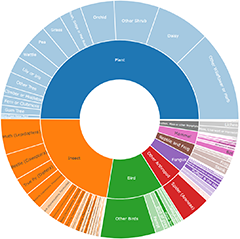Lions Youth Haven - Westwood Farm A.C.T. species
Overview
The Lions Youth Haven at Westwood Farm (private property) is a haven for youth at risk in our community.
Objectives of the Youth Haven:
- allow young people in situations of crisis to find a refuge and support;
- provide support for disengaged young people where they can gain confidence and self respect;
- provide these young people with training in basic skills which equip them better to fill their places in society as self-sufficient and productive individuals; and give these young people a place in the outdoors to learn about and develop their own dignity in an outdoor environment.
Westwood Farm consists of 200 hectares of open native woodlands and introduced pasture plants, with native grasses and groundcovers along creeklines. Neighbouring reserves include the Bullen Range Nature Reserve and McQuoids Hill Nature Reserve. The dominant woodland trees are Blakely's Red Gums and Yellow Box, which are a component of the endangered Yellow Box-Blakely's Red Gum Woodland ecological community. Older trees and dead standing trees have hollows which provide habitat for a number hollow-nesting birds, reptiles, frogs and invertebrates. Fallen timber is left to provide habitat for invertebrate species dependent on decaying wood for their survival. Nine small woodland birds have been recorded nesting in the foliage of young Blakely's Red Gum trees on the Farm: Diamond Firetail, Red-browed Finch, White-throated Gerygone, Western Gerygone, Mistletoebird, Yellow-rumped Thornbill, Weebill, Willie Wagtail and Grey Fantail. There are a number of horse agistment paddocks and a few larger stock grazing paddocks.
Significant sightings on the Farm include:
Moderators
Become the first moderator for Lions Youth Haven - Westwood Farm A.C.T.
95 species
- Area (hectares) 196.32 ha
- Survey Effort Score (SES) 10.05 sightings per ha
Follow Lions Youth Haven - Westwood Farm A.C.T.
Receive alerts of new sightings
SubscribeConservation level
- All conservation levels (change?)
Invasiveness
- All invasiveness levels (change?)
Plants
- Daisies
- Lilies & Irises
- Peas
- Other Wildflowers & Herbs
- Orchids
- Wattles
- Gum Trees
- Other Trees
- Other Shrubs
- Climbers & Mistletoes
- Ferns and Clubmosses
- Grasses
- Rushes, Sedges & Mat Rushes
- Other Fresh Water Plants
- Cacti & Succulents
- Marine Water Plants
Share location
Share link to Lions Youth Haven - Westwood Farm A.C.T. field guide
































































